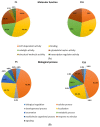The Potential Connection between Molecular Changes and Biomarkers Related to ALS and the Development and Regeneration of CNS
- PMID: 36232667
- PMCID: PMC9570269
- DOI: 10.3390/ijms231911360
The Potential Connection between Molecular Changes and Biomarkers Related to ALS and the Development and Regeneration of CNS
Abstract
Neurodegenerative diseases are one of the greatest medical burdens of the modern age, being mostly incurable and with limited prognostic and diagnostic tools. Amyotrophic lateral sclerosis (ALS) is a fatal, progressive neurodegenerative disease characterized by the loss of motoneurons, with a complex etiology, combining genetic, epigenetic, and environmental causes. The neuroprotective therapeutic approaches are very limited, while the diagnostics rely on clinical examination and the exclusion of other diseases. The recent advancement in the discovery of molecular pathways and gene mutations involved in ALS has deepened the understanding of the disease pathology and opened the possibility for new treatments and diagnostic procedures. Recently, 15 risk loci with distinct genetic architectures and neuron-specific biology were identified as linked to ALS through common and rare variant association analyses. Interestingly, the quantity of related proteins to these genes has been found to change during early postnatal development in mammalian spinal cord tissue (opossum Monodelphis domestica) at the particular time when neuroregeneration stops being possible. Here, we discuss the possibility that the ALS-related genes/proteins could be connected to neuroregeneration and development. Moreover, since the regulation of gene expression in developmental checkpoints is frequently regulated by non-coding RNAs, we propose that studying the changes in the composition and quantity of non-coding RNA molecules, both in ALS patients and in the developing central nervous (CNS) system of the opossum at the time when neuroregeneration ceases, could reveal potential biomarkers useful in ALS prognosis and diagnosis.
Keywords: ALS-related genes; CNS development; amyotrophic lateral sclerosis; neuroregeneration; non-coding RNAs; peripheral biomarkers.
Conflict of interest statement
The authors declare no conflict of interest.
Figures




References
-
- Arai T., Hasegawa M., Akiyama H., Ikeda K., Nonaka T., Mori H., Mann D., Tsuchiya K., Yoshida M., Hashizume Y., et al. TDP-43 is a component of ubiquitin-positive tau-negative inclusions in frontotemporal lobar degeneration and amyotrophic lateral sclerosis. Biochem. Biophys. Res. Commun. 2006;351:602–611. doi: 10.1016/j.bbrc.2006.10.093. - DOI - PubMed
Publication types
MeSH terms
Substances
Grants and funding
- P3-0427 and P1-0170/Slovenian Research Agency
- IP-2016-06-7060/Croatian Science Foundation
- uniri-biomed-18-258-6427, uniri-prirod-18-290-1463 and uniri-sp-biomed-19-50-1560/University of Rijeka
- CRP/CRO14-03/International Centre for Genetic Engineering and Biotechnology
- FONCYT, PICT-2020-SERIEA-00928/Austral University
LinkOut - more resources
Full Text Sources
Medical
Miscellaneous

